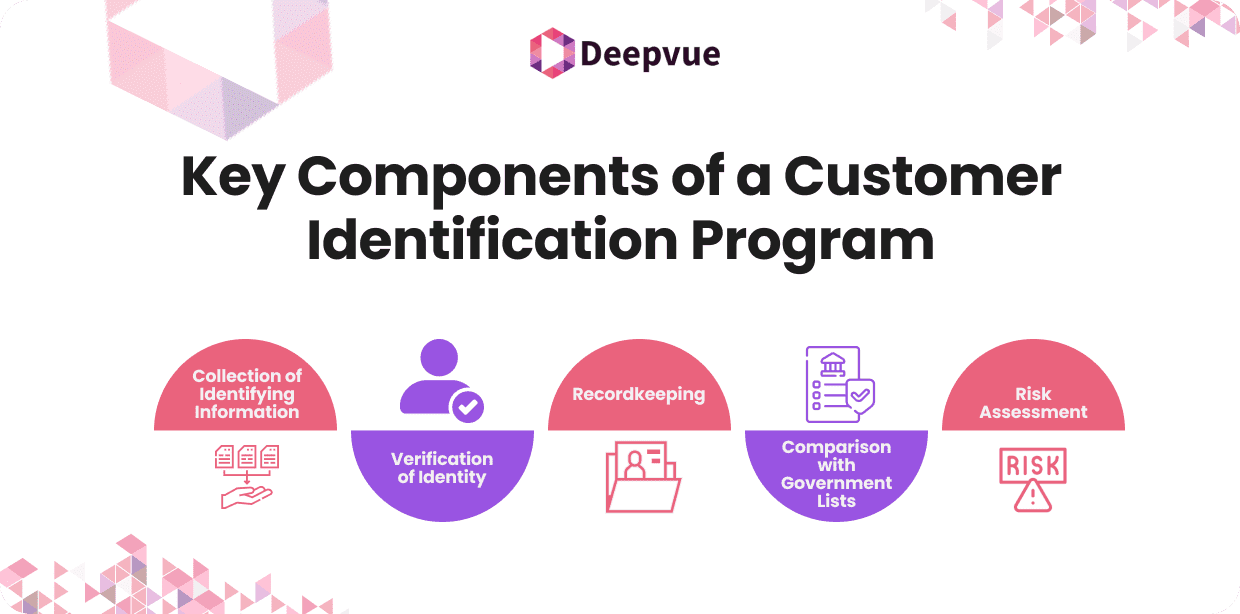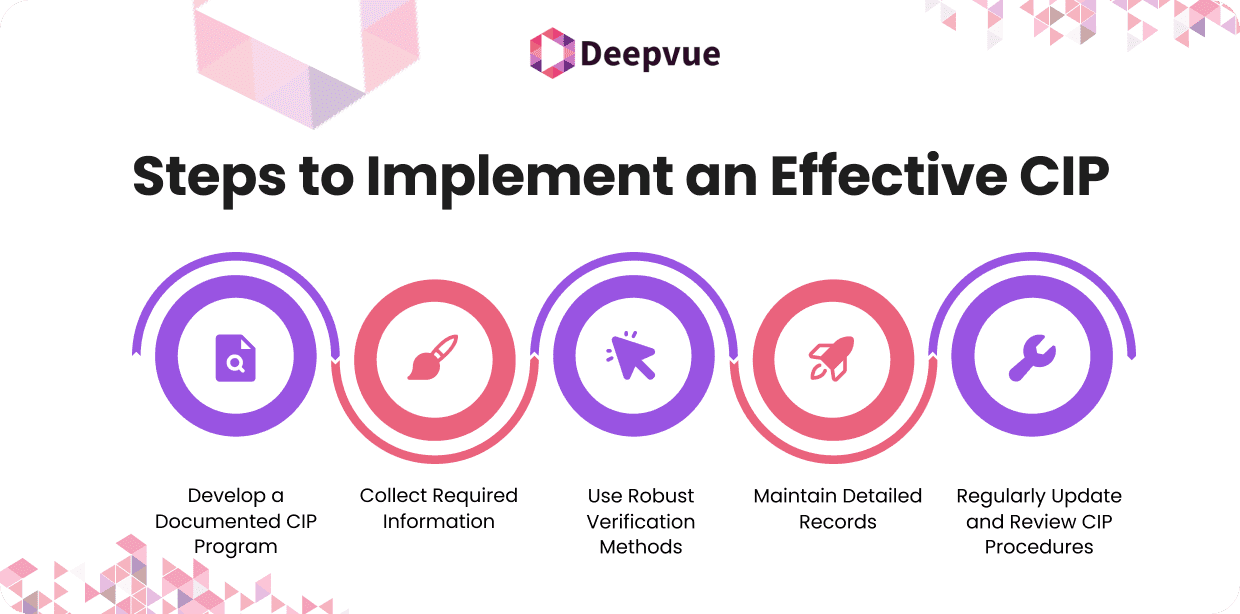Ensuring the legitimacy of customers is of utmost importance in this current digital scenario. This is where the Customer Identification Program (CIP) comes into play. A CIP is a set of procedures that financial institutions use to verify the identity of their customers.
This process is essential for meeting Know Your Customer (KYC) compliance obligations and preventing illicit activities such as money laundering and fraud.
What is a Customer Identification Program (CIP)?
A Customer Identification Program (CIP) involves collecting specific information from customers to verify their identities. This is mandated by laws & regulations, which requires financial institutions to have a documented CIP in place. The primary goal of CIP is to ensure that institutions know who their customers are, which helps in assessing the risk they might pose.
Key Components of a Customer Identification Program
Collection of Identifying Information
Financial institutions must gather basic information from customers, including:
- Full name
- Date of birth
- Address
- Identification ID or number (e.g., Aadhaar, PAN, driving license, etc)
Verification of Identity
The information collected must be verified using reliable methods. This can include documentary verification (e.g., checking a government-issued ID) and non-documentary methods (e.g., cross-referencing information with databases).
Recordkeeping
Institutions are required to maintain records of the information used to verify a customer’s identity. These records must be kept for at least five years after the account is closed.
Comparison with Government Lists
Customers’ names and identifying information must be checked against government lists of known or suspected terrorists and other high-risk individuals.
Risk Assessment
Institutions should assess the risks associated with their customer base and service offerings. This involves understanding the potential risk each customer might pose based on factors such as their location and the nature of their business activities.

Comparison With Government Lists in CIP
1. Office of Foreign Assets Control (OFAC) List
- Purpose: Identifies individuals, entities, and countries subject to economic sanctions.
- Use in CIP: Ensures businesses do not engage in financial transactions with sanctioned parties.
2. Politically Exposed Persons (PEP) List
- Purpose: Contains names of individuals in prominent political positions or those with a high corruption risk.
- Use in CIP: Helps financial institutions assess the risk level of customers and implement enhanced due diligence when necessary.
3. Financial Crimes Enforcement Network (FinCEN) List
- Purpose: Maintains a database of individuals and entities suspected of involvement in money laundering or financial crimes.
- Use in CIP: Assists in detecting and reporting suspicious activities.
4. Anti-Money Laundering (AML) and Know Your Customer (KYC) Watchlists
- Purpose: Track individuals and organizations involved in fraudulent or illegal financial activities.
- Use in CIP: Helps in risk profiling and compliance checks.
5. National Identity and Address Verification Databases
- Purpose: Includes Aadhaar (India), Social Security (US), and other government-issued identity systems.
- Use in CIP: Ensures accurate verification of customer identity and addresses.
6. International Criminal Databases (Interpol and Other Global Lists)
- Purpose: Identify individuals involved in cross-border criminal activities.
- Use in CIP: Assists global financial institutions in maintaining compliance across multiple jurisdictions.
The Importance of CIP in Banking
In the banking sector, CIP is crucial for several reasons:
- Compliance: It ensures that banks comply with legal and regulatory requirements.
- Risk Management: By verifying customer identities, banks can better manage and mitigate risks associated with financial crimes.
- Trust and Security: It helps in building trust with customers by ensuring their identities are protected.
CIP vs. KYC: What’s the Difference?
While CIP is a component of KYC, they are not the same.
KYC involves a broader set of processes to understand a customer’s identity and business activities. CIP specifically focuses on verifying the information provided by the customer.
Essentially, CIP is the first step in the broader KYC process, aimed at establishing the identity of customers.
How to Build & Implement a Strong Customer Identification Program
- Develop a Documented CIP Program – Create a formal plan outlining how your institution will identify and verify customers. This plan should be tailored to your business’s specific needs and risk profile.
- Collect Required Information – Ensure that you collect all necessary information from customers during the onboarding process. This includes both individual and business customers.
- Use Robust Verification Methods – Implement both documentary and non-documentary methods to verify customer identities. Use technology where possible to streamline the process.
- Maintain Detailed Records – Keep comprehensive records of the information used for identity verification. This includes copies of documents and notes on non-documentary verification methods used.
- Regularly Update and Review CIP Procedures – Regularly review and update your CIP to ensure it remains effective and compliant with current regulations. This includes ongoing monitoring of customer information against government lists.

Challenges in Implementing CIP
Implementing a CIP can come with several challenges:
- Data Accuracy: Ensuring the accuracy of the information collected can be difficult, especially with non-documentary verification methods.
- Regulatory Changes: Keeping up with changes in regulations can be challenging, requiring institutions to regularly update their CIP procedures.
- Balancing Security and Customer Experience: While thorough verification is crucial, it should not overly burden the customer, impacting their experience negatively.
Leveraging Technology for CIP
Technological advancements have made it easier to implement effective CIPs. Solutions like AI-based compliance tools can help streamline the verification process and improve accuracy. Automated tools can handle large volumes of data and provide real-time screening against sanctions and watchlists, ensuring ongoing compliance.
Conclusion
A Customer Identification Program is a fundamental aspect of financial security and compliance. By ensuring that customers are who they claim to be, financial institutions can prevent fraud, money laundering, and other financial crimes. Implementing an effective CIP requires a combination of thorough data collection, robust verification methods, and ongoing monitoring. Leveraging technology can enhance the efficiency and effectiveness of CIP, ensuring that institutions stay compliant while providing a seamless customer experience.
To learn more about how Deepvue’s Verification Suite can enhance the verification process, visit Deepvue.tech and explore our range of APIs designed to ensure accuracy and efficiency.
FAQs
What information is required for a Customer Identification Program?
A CIP typically requires the collection of a customer’s full name, date of birth, address, and an unique identification proof such as a PAN, aadhaar, driving license, etc.
How does CIP differ from KYC?
CIP is a part of the broader KYC process. While CIP focuses on verifying the identity of customers, KYC involves a more comprehensive understanding of a customer’s identity and business activities.
What methods are used for identity verification in CIP?
Identity verification can be done using documentary methods (e.g., checking a government-issued ID) and non-documentary methods (e.g., cross-referencing information with databases).
Why is recordkeeping important in CIP?
Recordkeeping is crucial for maintaining compliance with regulations. It ensures that all information used to verify a customer’s identity is documented and can be reviewed in case of audits or investigations.
How can technology enhance CIP processes?
Technology, such as AI-based compliance tools and services like Deepvue , can streamline the CIP process by automating identity verification, providing real-time screening against sanctions and watchlists, and ensuring ongoing compliance.
How does CIP help prevent financial crimes?
Customer Identification Program (CIP) helps prevent financial crimes by verifying the identity of customers during account opening. It ensures compliance with KYC regulations, detects fraudulent identities, and mitigates risks related to money laundering, terrorism financing, and other illicit activities.








